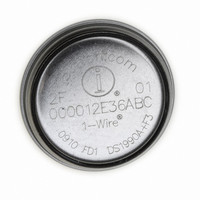DS1985-F5+ Maxim Integrated Products, DS1985-F5+ Datasheet - Page 2

DS1985-F5+
Manufacturer Part Number
DS1985-F5+
Description
IBUTTON 16KBit ADD-ONLY F5
Manufacturer
Maxim Integrated Products
Series
iButton®r
Datasheet
1.DS1985-F5.pdf
(26 pages)
Specifications of DS1985-F5+
Rohs Information
IButton RoHS Compliance Plan
Memory Size
2KB
Memory Type
EPROM
Lead Free Status / RoHS Status
Lead free / RoHS Compliant
DS1985
iButton DESCRIPTION
The DS1985 16Kb Add-Only iButton is a rugged read/write data carrier that identifies and stores relevant
information about the product or person to which it is attached. This information can be accessed with
minimal hardware, for example a single port pin of a microcontroller. The DS1985 consists of a factory-
lasered registration number that includes a unique 48-bit serial number, an 8-bit CRC, and an 8-bit Family
Code (0BH) plus 16Kb of EPROM that is user-programmable. The power to program and read the
DS1985 is derived entirely from the 1-Wire communication line. Data is transferred serially via the
1-Wire protocol that requires only a single data lead and a ground return. The entire device can be
programmed and then write-protected if desired. Alternatively, the part may be programmed multiple
times with new data being appended to, but not overwriting, existing data with each subsequent
programming of the device. Note: Individual bits can be changed only from a logical 1 to a logical 0,
never from a logical 0 to a logical 1. A provision is also included for indicating that a certain page or
pages of data are no longer valid and have been replaced with new or updated data that is now residing at
an alternate page address. This page address redirection allows software to patch data and enhance the
flexibility of the device as a standalone database. The 48-bit serial number that is factory-lasered into
each DS1985 provides a guaranteed unique identity that allows for absolute traceability. The durable
MicroCan package is highly resistant to harsh environments such as dirt, moisture, and shock. Its compact
button-shaped profile is self-aligning with cup-shaped receptacles, allowing the DS1985 to be used easily
by human operators or automatic equipment. Accessories permit the DS1985 to be mounted on printed
circuit boards, plastic key fobs, photo-ID badges, ID bracelets, and many other objects. Applications
include work-in-progress tracking, electronic travelers, access control, storage of calibration constants,
and debit tokens.
OVERVIEW
The block diagram in Figure 1 shows the relationships between the major control and memory sections of
the DS1985. The DS1985 has three main data components: 1) 64-bit lasered ROM, 2) 16384-bits
EPROM Data Memory, and 3) 704-bits EPROM Status Memory. The device derives its power for read
operations entirely from the 1-Wire communication line by storing energy on an internal capacitor during
periods of time when the signal line is high and continues to operate off of this “parasite” power source
during the low times of the 1-Wire line until it returns high to replenish the parasite (capacitor) supply.
During programming, 1-Wire communication occurs at normal voltage levels and then is pulsed
momentarily to the programming voltage to cause the selected EPROM bits to be programmed. The
1-Wire line must be able to provide 12 volts and 10 milliamperes to adequately program the EPROM
portions of the part. Whenever programming voltages are present on the 1-Wire line a special high
voltage detect circuit within the DS1985 generates an internal logic signal to indicate this condition. The
hierarchical structure of the 1-Wire protocol is shown in Figure 2. The bus master must first provide one
of the four ROM Function Commands, 1) Read ROM, 2) Match ROM, 3) Search ROM, 4) Skip ROM.
These commands operate on the 64-bit lasered ROM portion of each device and can singulate a specific
device if many are present on the 1-Wire line as well as indicate to the bus master how many and what
types of devices are present. The protocol required for these ROM Function Commands is described in
Figure 8. After a ROM Function Command is successfully executed, the memory functions that operate
on the EPROM portions of the DS1985 become accessible and the bus master may issue any one of the
Figure 8. After a ROM Function Command is successfully executed, the memory functions that operate
on the EPROM portions of the DS1985 become accessible and the bus master may issue any one of the
five Memory Function Commands specific to the DS1985 to read or program the various data fields. The
protocol for these Memory Function Commands is described in Figure 5. All data is read and written least
significant bit first.
2 of 26












